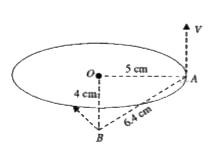An electorn moves in a circle of radius 10cm with a constant speed of 4.0×106ms−1.Find the electric current at a point on the circle.
To find the electric current at a point on the circle where an electron moves, we can follow these steps:
Step 1: Understand the relationship between current, charge, and time
The electric current I is defined as the charge q that passes through a point in a circuit per unit time t:
I=qt
In this case, the charge q is the charge of an electron, denoted as e.
Step 2: Calculate the time taken for one complete revolution
The time t for one complete revolution of the electron can be calculated using the formula:
t=DistanceSpeed
The distance for one complete revolution (circumference of the circle) is given by:
Distance=2πr
where r is the radius of the circle. Given that r=10 cm=10×10−2 m and the speed v=4.0×106 m/s, we can substitute these values into the equation.
Step 3: Substitute values to find time
Substituting the values into the formula for time:
t=2π(10×10−2)4.0×106
Calculating the circumference:
Distance=2π(0.1)≈0.628 m
Now substituting this into the time equation:
t=0.6284.0×106≈1.57×10−7 s
Step 4: Calculate the current
Now we can calculate the current using the charge of an electron, which is approximately e=1.6×10−19 C:
I=et
Substituting the values:
I=1.6×10−191.57×10−7
Calculating the current:
I≈1.02×10−12 A
Final Answer
Thus, the electric current at a point on the circle is approximately:
I≈1.0×10−12 A
The electric current I is defined as the charge q that passes through a point in a circuit per unit time t:
I=qt
In this case, the charge q is the charge of an electron, denoted as e.
The time t for one complete revolution of the electron can be calculated using the formula:
t=DistanceSpeed
The distance for one complete revolution (circumference of the circle) is given by:
Distance=2πr
where r is the radius of the circle. Given that r=10 cm=10×10−2 m and the speed v=4.0×106 m/s, we can substitute these values into the equation.
Substituting the values into the formula for time:
t=2π(10×10−2)4.0×106
Calculating the circumference:
Distance=2π(0.1)≈0.628 m
Now substituting this into the time equation:
t=0.6284.0×106≈1.57×10−7 s
Now we can calculate the current using the charge of an electron, which is approximately e=1.6×10−19 C:
I=et
Substituting the values:
I=1.6×10−191.57×10−7
Calculating the current:
I≈1.02×10−12 A
Thus, the electric current at a point on the circle is approximately:
I≈1.0×10−12 A
Topper's Solved these Questions
- BOOK - HC VERMA ENGLISHCHAPTER - ELECTRIC CURRENT IN CONDUCTORSEXERCISE - Objective 115videos
ELECTRIC CURRENT IN CONDUCTORS
- BOOK - HC VERMA ENGLISHCHAPTER - ELECTRIC CURRENT IN CONDUCTORSEXERCISE - objective 29videos
ELECTRIC CURRENT IN CONDUCTORS
- BOOK - HC VERMA ENGLISHCHAPTER - ELECTRIC CURRENT IN CONDUCTORSEXERCISE - questions for short answer17videos
ELECTRIC CURRENT IN CONDUCTORS
- BOOK - HC VERMA ENGLISHCHAPTER - DISPERSION AND SPECTRAEXERCISE - Question for short Answer6videos
DISPERSION AND SPECTRA
- BOOK - HC VERMA ENGLISHCHAPTER - ELECTRIC CURRENT THROUGH GASESEXERCISE - Short answer6videos
ELECTRIC CURRENT THROUGH GASES
Similar Questions
Knowledge Check
- Question 1 - Select One
Find the area of a circle of radius 5.6 cm.
A58.56cm2.B78.56cm2.C98.56cm2.D88.56cm2.
A particle is moving on a circular track of radius 30 cm with a constant speed of 6ms−1. Its acceleration is
View SolutionA particle moves in a circle of radius 4 m with a linear velocity of 20ms−1. Find the angular velocity.
View SolutionAn electron revolves in a circle of radius 0.4A0 ith a speed of 106ms−1 in a hydrogen atom. The magnetic field produced at the centre of the orbit due to motion of the electron, in tesla, is [μ0=4π×10−7H/m]
View SolutionFind the area of a circle of radius 4.2 cm
View SolutionImagine that an electron revolves around a circle of the radius 5.3×10−11m with a linear speed of 7.5×104ms−1 in a hydrogen atom. The magnetic field produced at the centre of the circle, due to the electron, is
View SolutionA particle is moving in a circle of radius 1 cm and with a constant speed of 8cms−1 . Centre of the circle lies on principle axis of a converging lens of focal length 50 cm and at a distance of 75 cm from the lens . Plane of the circle is perpendicular to principle axis. The correct statement is
View SolutionA particle of mass 50 gm moving in a circle at 5 cm radius with a constant speed of 10 cm/s. What is its angular momentum about (i) centre of the circle, (ii) a point on the axis of the circle at 4 cm distance from its centre ? Which of these will be always in the same direction ? [Fig.]
 View Solution
View Solution

